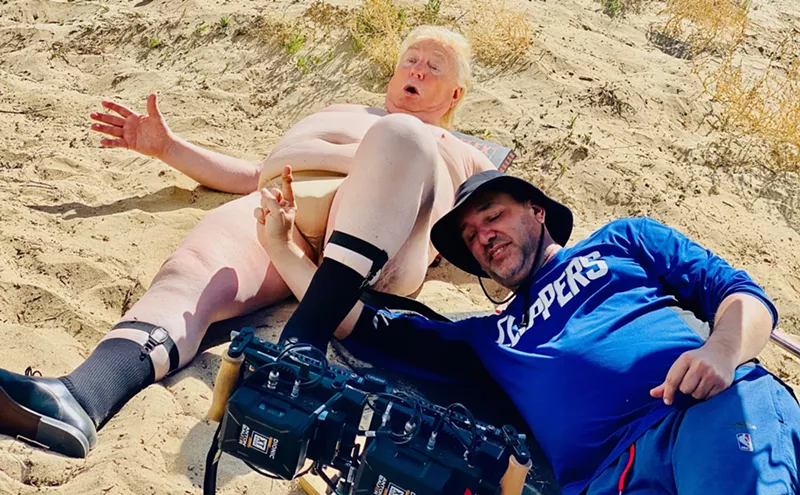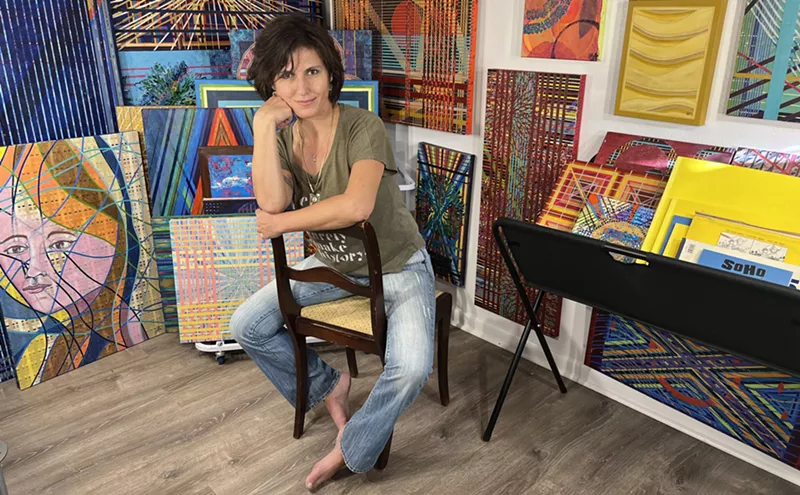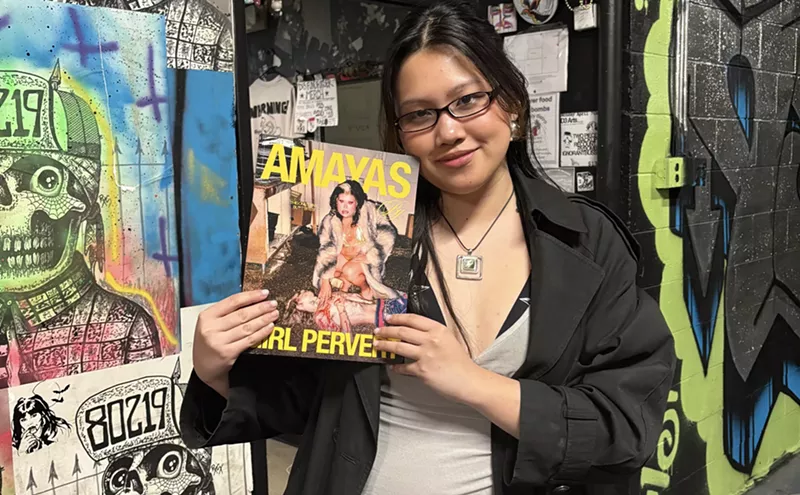
Have you seen those YouTubes of twin babies talking to each other, and it doesn't make any sense but they're communicating?" Corey Knapper asks. He and his brother, Jesse, are like that. At 24, they still have a secret language of gasps and glances, as well as a secret gang of cartoon friends.
They're inseparable. They make art together, work together and live together in southwest Denver. In their downtime, they play disc golf together, and they're thinking of signing up for a tournament: They think they'd make a killer doubles team.
The Knapper twins are identical. Most people can't tell them apart by looks, personality or speech. Rooms are "raging," and folks at Phish shows are "faded"; "It's all good" is one of their favorite phrases. Both dress in baggy graphic tees and loose-fitting jeans. But the Lakewood Police Department was able to find distinguishing characteristics: According to investigators, Corey has a "casual" appearance, while Jesse has a "sloppy" one. Their hair and facial hair are always changing, too. That's Corey with the heavy mustache in the Wheat Ridge mug shots.
*****
Being teenagers in Phoenix was so boring that the Knappers made their own fun by skateboarding off rooftops and videotaping the antics. Then they decided to collect some cash by designing T-shirts that they'd sell at parties. "You'd wake up in the morning with your pockets stuffed with cash and say, 'I hope I didn't fuck up last night, because I don't have any shirts left!'" Corey remembers.
Their parents told them they needed to get serious. While this admonition would put many nineteen-year-olds on the nine-to-five treadmill, the elder Knappers were okay with their sons going to art school. So after a couple of years at an Arizona community college, Corey and Jesse packed up their 1994 Infiniti and headed to Colorado, where they enrolled at the Rocky Mountain College of Art and Design in 2008. While Jesse studied communications and design, which he shorthands to "graphic design," Corey majored in fine arts; both maintained near-4.0 GPAs.
During winter break in Arizona last year, the twins decided to create a gang of cartoon characters. Playing off "It's all good," they wondered what kind of character Saul Gud might be. For a while, a drug-addicted but chipper homeless man Corey had met on East Colfax was the top contender. But when the pair decided that Saul sounded biblical, it clicked instantly. Jesse Google-imaged "religious Jewish man," then vectorized one of the images that came up. Saul Gud, a Hasidic Jewish man with a strong nose, a snazzy hat and an impressive beard, was the first member of the Slang Gang.
Slide show: Meet the "Slang Gang"
Other characters soon followed: Pho Reel, a smiling, bearded Asian man; Ray Jin, a gym-rat juicehead with bleached tips and a snarl; Fay Did, a girl who's enjoying the effects of MMJ to the fullest; Buzz Kill, a domineering cop who does not look amused; Saight, a seeing-eye dog; Kay Pasha, a seductive Latina girl; Das Kuhl, a beefy German man; and Klee Che, a spoof of the iconic Che Guevara image that the twins were so tired of after three years in art school.
Accompanied by the Slang Gang, they returned to school with new energy. Corey had signed up for a street-art class taught by associate professor Sandra Ceas, the former interim chair of art education at RMCAD. Ceas saw that street art had turned away from gang-related messages to become a free and public medium for the purposes of beautification, awareness and humor. So in November 2010, she proposed a street-art class to RMCAD administrators. They approved it right away, she remembers, "which was kind of surprising, since it was quite cutting-edge."
By then, the school had received a lot of student requests for such a class. "Street art is an important part of the art world, and increasingly so," notes Karen Wachtel, RMCAD's director of communications.
Still, there's plenty of confusion over the role of street art.
"A lot of students did take the class thinking it'd be a graffiti class, and right away I said, 'It's not about graffiti. It's not about vandalism. It's about having a public voice,'" Ceas recalls. "And right away, the students responded in tune with that."
The legality of street art — or lack thereof — was often a point of discussion in class. Laws pertaining to graffiti, vandalism and other related activities in Jefferson County and the city of Denver were posted on the class's Digication portal, a website that students could access that included a syllabus, homework assignments, readings and other course-related materials. Although Ceas never required students to break laws for the sake of the class, she didn't discourage it, either. "Even though if you were to technically say, 'You are making art on something you do not own, you are vandalizing,' the students who are artists and want to work in this genre are saying that we should have equal rights to a voice in public," Ceas says. And so she asked her students questions like: What's the responsibility that goes with doing this sort of work? And, even, am I willing to get arrested for it?
During the course of the class, Corey and Jesse became serious about the Slang Gang. They started pumping out massive posters — some as big as eight feet long — featuring the characters. They also made stickers that were smaller than the palm of your hand. Jesse got credit for the project as an independent study.
And they weren't just making art, they were putting it on display, too. In March, the Slang Gang suddenly started turning up on posters stuck to the sides of buildings, parking structures, traffic signs and billboards. "We put them in spots where they couldn't get them down, basically," Corey says. They scaled buildings and leaned over the edges of rooftops, using all the dexterity they'd learned while skateboarding off rooftops. In class, Corey played videos and showed photos of the brothers putting up Saul Gud posters in the middle of the night.
The twins hit parts of town that were frequent street-art targets, such as downtown Denver, as well as spots in the suburbs that weren't as accustomed to tagging. "You don't expect to see posters while you're cruising through Arvada," says Jeremy Silas Ulibarri, a street artist better known as Jolt. "That's what I was getting a kick out of."
"I think we were doing it for a good cause," Corey says. "Make people laugh when they're stuck in traffic." A good cause that wasn't about racism, they insist, wasn't about stereotypes, wasn't about vandalism. It was just about fun.
They knew it was against the law to post posters without permission. But they thought they were mostly doing it on vacant buildings, and besides, they were using wheat paste — a mix of flour and water with a dash of sugar that comes off after a few months when exposed to the elements, but in the meantime holds on tight. They figured people would enjoy their art so much that it wouldn't be a big deal.
But it did turn into a big deal when some suburban cops thought the posters represented the work of a real gun-toting, drug-dealing, threatening-the-lives-of-our-children gang. The Knappers' inside joke soon grabbed the attention of the West Metro Drug Task Force, an organization better known for busting meth labs and cocaine smugglers than art-school students.
*****
On March 26, Corey got a call from Brad Pittman. He said he was the owner of Rock Rest Lodge in Golden and had seen Saul Gud, Ray Jin and Pho Reel posters around town. He liked them so much, he wanted four for his bar — and was willing to pay $50 for each of them.
Making money off of art — it was an art student's dream. But the deal was so modest, it didn't seem too good to be true. "It seemed plausible," Corey remembers. "I'd been [to Rock Rest] before to get a beer." A few days later, Pittman called again and told Corey that he and his bar manager, Pat, could get together with the twins at the King Soopers at West 38th Avenue and Sheridan Boulevard in Wheat Ridge.
The Knappers met Pittman and Pat in the supermarket parking lot on March 30. Pittman and Pat asked to see a poster of Saul Gud. The twins grabbed a few posters from the back of their other vehicle, a Toyota Tacoma, and began to unroll one.
"The second we unrolled it, SWAT had us on a car," Jesse remembers.
"I got tackled," Corey says. "Jesse got pushed up against a car. It was pretty extreme." The two were taken to the Wheat Ridge police station, processed, each charged with four counts of trespassing and four counts of defacing property, and released.
The men that Jesse thought were SWAT officers were Wheat Ridge cops, working with members of the West Metro Drug Task Force. Brad Pittman was actually J. Simpson, an officer with the Wheat Ridge Police Department, and Pat was Detective Pat Schreiner with the WMDTF; six additional officers provided cover.
The Wheat Ridge investigation of the Slang Gang had started on March 24, prompted by two property owners' complaints about graffiti. Simpson had studied the Slang Gang on Facebook. "I was able to view an album titled 'Homies' by 'Ray Jin' on Facebook," his report notes. He'd figured out that purported gang leader Corey was a RMCAD student because most of his Facebook friends were in the RMCAD network; he'd then gotten Corey's number from RMCAD's street-art class portal. After making contact with Corey, he'd requested $1,000 in marked bills from the WMDTF, as well as audio and visual recording equipment.
"West Metro was involved because they have resources that we don't," explains Lisa Spinder, public information officer at the Wheat Ridge Police Department, adding that such resources, including recording equipment, are necessary because "getting the information directly from the mouths of the suspects, it's how you build a case."
And then Simpson set up the sting to capture the Slang Gang.
"When I asked him what the names meant, he said that they were part of the 'Slang Gang' and that putting up the posters is what they liked to do," Simpson's report continues.
A total of 25 posters were hauled off as evidence.
The officers definitely appreciated at least one piece of art: Buzz Kill, the cop character. They "were cracking up when they saw Buzz Kill," Jesse adds, beaming a little with pride. "They were all laughing."
The next day, when Jesse returned home from class, a large, dark-colored truck was sitting outside the Lakewood apartment he shared with Corey. "I looked at one of the guys in there, and he looked at me, and I thought, 'That looks a little suspicious,'" Jesse remembers.
He ran into Corey in the stairwell, and they chatted about how crazy the sting had been.
Then things got crazier. Before they knew it, cops had them down on the ground. This time, it was the Lakewood Police Department.
The Lakewood officers didn't have a search warrant for the apartment, and they threatened to kick down the door if the twins didn't let them in. The Knappers refused and were taken to Lakewood police headquarters. They were soon released and went to Holiday Lanes, a weekly routine. So they weren't home at 11 p.m. on March 31 when the cops showed up at their apartment again, this time with a warrant.
"They tore our apartment apart," Jesse says. "I don't know what they thought they were going to find."
The officers took the twins' three laptop computers, one desktop computer, an external hard drive, two still cameras and three video cameras, as well as a skateboard with a Saul Gud sticker on it, posters, more stickers, incense and the marijuana Corey had as a caretaker. They left behind the vase they broke.
"You'd think when they went into our apartment and it's art galore — the walls are covered in art — they wouldn't think, 'Oh, you're a gang,'" Jesse says.
The Knappers were at a friend's house when they got a call at 12:30 a.m. from the Lakewood PD, which was now demanding access to their truck ASAP — otherwise, it would be impounded. Worried about being thrown on the ground again, they give their keys to the friend, who drove the Tacoma to the police station, where he also handed over a few more Slang Gang posters.
Lakewood ultimately charged each of the Knappers with fourteen counts of defacing property and eight counts of trespassing.
The Lakewood investigation was opened on March 28. In the files, the Slang Gang is frequently referred to as a "tag krew."
"We think they thought it was a Jewish gang or something weird," Jesse says.
"They probably think there's a Fay Did out there running rampant," Corey jokes.
The twins deny any involvement with a gang. And until these arrests, their records were clean.
The Knappers pleaded guilty to all charges — although a few were dismissed because the owners didn't bother to respond when police notified them that their property had been defaced. In court, their lawyer, Jack Weatherill, brought up their lack of a record and their near-perfect GPAs, and showed the judge letters testifying to their good character written by three RMCAD professors, including Ceas. "They're putting a smile on a lot of faces, and their intentions and aims are legitimately healthy," Ceas says. "They're talented and not ego-driven."
"I tried to differentiate the Knapper twins from the typical taggers," says Weatherill. "There were a lot of differences between those two and the typical people charged with tagging."
And the brothers got off fairly lightly. "At the restitution hearing, it was kind of weird. I felt like the judge even had our back a little bit," Jesse says of Lakewood Municipal Court, where they were each ordered to pay $349 in restitution and complete more than fifty hours of community service. Otherwise, their sentencing was deferred: As long as they stay out of trouble for a year, the record of their arrests will be expunged, with no further probation or jail time. But in the meantime, they're not allowed to go near any sites they tagged.
"I was really irritated," says Tiffany Harrold, owner of Ace Pack and Ship in Lakewood, which was tagged. While some work was being done on the side of her building, the Knappers had put up Saul Gud posters. She got a couple of comments about it from customers and decided that the posters looked tacky. The workmen already doing work on the building covered up the poster, and she shot the character a pissed-off Facebook message. The Knappers responded with a Facebook-messaged apology; they thought the section of the building where the work was being done was abandoned. "But to be honest, it was more funny than anything and didn't really hurt me at all," she says.
In Wheat Ridge, the twins were ordered to pay $575 total in restitution and serve forty hours of community service. They also picked up court costs.
But they may not be out of the woods yet. Lakewood officers told the Knappers that the City of Denver was after them — although they have yet to hear from anyone in the city. "We did get a weird post on Facebook," Corey says. "It was an older dude saying, 'Yeah, I want to buy some of these for my family. I think they're hilarious.'"
They didn't respond, and they haven't heard back from the dude.
*****
Graffiti matters to city officials because people complain about it.
"Graffiti is one of the top complaints we receive from everybody — residents, property owners and businesses," says Lakewood spokeswoman Stacie Oulton. "These were privately owned buildings with these posters on it, and no matter how beautiful or innovative graffiti might be, it's still an unwanted item unless the property owner gives express permission."
So in response, Lakewood officials are going after taggers. Thus far in 2011, over 700 incidents of graffiti have been reported in that town, and the city has already arrested 34 people and filed 44 cases in court. In 2010, 63 graffiti-related arrests were made in Lakewood.
Wheat Ridge got 325 reports of tagging between January and August of this year — up from a total of 285 in 2010.
But according to the Jefferson County Sheriff's Office, out of nearly 300 reported incidents of graffiti in 2006, fewer than 10 percent were even marked as gang-related.
Fighting graffiti is also one of Denver's top priorities. Denver has two full-time graffiti officers. In 2010, the Department of Public Works spent $1,375,371 on removing graffiti, including paying a private contractor whose sole job is to drive around downtown and take down or paint over tags. In 2008, Denver arrested 831 people for graffiti-related violations.
"It's way up there with quality-of-life issues," says Councilwoman Judy Montero, whose district covers much of downtown.
Constituents notice when graffiti increases in her district, says Councilwoman Jeanne Robb: "I don't know if people connect [graffiti] with violence, but they do connect it with a number of bad behaviors."
The number of people who connect graffiti with art is increasing — but slowly.
Artists like Banksy and Shepard Fairey have made names for themselves as major forces in the legitimate art world. Fairey's poster of Barack Obama with the word "Hope" became an icon during the 2008 presidential campaign, but that didn't keep him out of trouble with the law. Fairey was arrested in Denver for his postings at the Democratic National Convention, his fourteenth arrest at the time.
Like most graffiti artists, Jolt has a record; it comes with the territory. But in March 2010, he found himself wrongly lumped in with Denver gangs by the History Channel — while he was doing work with Denver Public Schools. "I've never tried to victimize myself," Jolt says. "Yeah, I'm an artist, but at the same time, I'm an outlaw. I do illegal graffiti. I'm a vandal. I embrace those parts of the culture. It's not a game; it's something that you do. It's a lifestyle. Along with the lifestyle can come legal ramifications."
In April, the Museum of Contemporary Art in Los Angeles opened "Art in the Streets," an exhibition of street art featuring site-specific installations as well as photographs of iconic tags; it was the first major exhibit in the United States devoted to the genre. The show was slated to appear at the Brooklyn Museum in 2012, but that has been canceled. The official explanation was funding problems, but it's also rumored that the Brooklyn Museum just didn't want the controversy and police attention that the MoCA show has attracted. Law enforcement officials in Los Angeles claim that tagging has gone up since the exhibit opened. So did museum attendance.
*****
At lunch at the Cooler in Edgewater, the Knappers have a few Slang Gang stickers out on the table. When the friendly blond waitress sees the characters, which she's spotted around town, she shrieks. "Did you guys do these? These are so hilarious!" she says, mildly starstruck. "This is so brilliant. Buzz Kill is my favorite one."
Tickled, the Knappers offer up big, toothy grins and give her Buzz Kill and Saul Gud stickers — after making her promise not to post them. As she thanks them, the twins reply in unison, "Saul Gud!"
Slide show: Meet the "Slang Gang"
If street art is meant to be about messages, at least some of the Knappers' work has been successful. "Knowing that people are getting happy, that's enough," Corey says. "It's just more positive energy in the world."
Through their arrests, the brothers managed to keep their jobs selling Comcast door-to-door. They like the work, because they like chatting with strangers. "We tell people about a promotion and they're like, 'For real?' and we're like, 'For real!'" Corey laughs.
Even if people don't order the Triple Play, which puts a $150 commission into a Knapper pocket, the twins will hand them a sticker or two if the customer was nice, or cool, or raging — but they do ask the customers to refrain from posting them around town.
The twins have stopped posting, too. They're still working with the Slang Gang characters — right now, they're playing around with Amfi Linnit, who would be a little Eskimo because "when you're feeling it, you're feeling the cold," Jesse says, plus "Linnit" sounds like "Inuit" — but they're putting the characters on canvas instead of walls for now. They want to produce Slang Gang T-shirts, too, but will have to finish paying off their court costs before they can start saving the $700 they need in start-up cash for that. And although they still have a stack of approximately 1,200 stickers, they give those out selectively. If Saul Gud or any of his gang suddenly showed up posted in the area, the Knappers' plea deal would disappear and all the charges would come hurtling back.
They graduated from RMCAD this past summer — thanks to professors who made deadlines flexible while the Knappers were dealing with the courts and were without their computers for four months. It took two hearings in front of a Lakewood judge before the computers, as well as the cameras and stickers, were returned in August.
Thinking about how much time Lakewood and Wheat Ridge officers spent going through their videos and pictures — looking for gang affiliations but mostly finding just sick shots of the twins skateboarding or hanging out with friends — still makes them laugh. But not hard enough to balance out getting busted.
Art school "kind of instills in you this idea that the world is your art canvas," Corey says. "You get arrested in the real world."
"As far as them getting caught, that comes with the territory," notes Jolt. "They did some damage. They put themselves out there. That's just a part of it. Hopefully, they won't quit."
The twins don't plan to quit. They're both pursuing careers in art, and they want to return to street art as a medium after their year-long deferred sentence is over.
They realize that at least a little of the magic of the medium comes from putting themselves in the government's way for the sake of art. "I get inspired by people going out and doing things on roofs," Jesse says. "When it's well done, it's art."
The fact that street art continues to tread the line between art and vandalism contributes to its power. "There are very successful street artists out there who see being arrested like being an activist," Ceas says.
As for her street-art class, it's currently in a state of arrested development. Although she says the class is "still in the mix" in RMCAD's fine-arts department, it's not being offered this fall. Or next spring.












